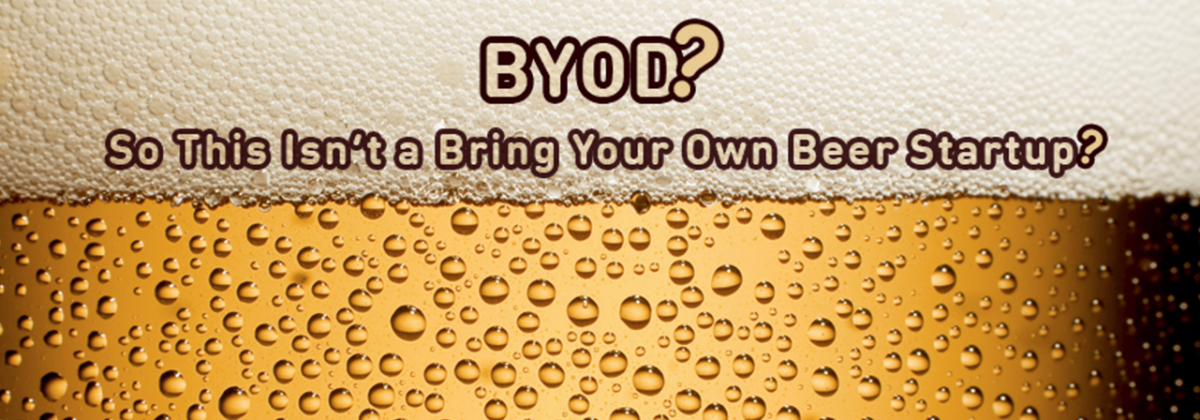When I first saw the job ad for Nubo last summer, I thought I was in heaven – “Bring Your Own Beer Startup.” “This looks interesting! I can definitely help them,” I said to myself. “Maybe there’ll be some good red wine too.” I scratched my eyes, read it again and realized my mistake. “Oh, BYOD. That’s Bring Your Own Device.”
BYOB, a “Bring Your Own Beer” startup? Oh, you mean BYOD – Bring Your Own Device.
I obviously had a lot to learn. I spent my first month at Nubo reading and listening. Even at lunch, everything the Android developers had to say was news to me. They were all generous with their time and within a few weeks I had a good understanding of the game changing mobile solution that is Nubo.
My challenge was to create a marketing language for Nubo, a new type of product that had never been described in English or any language. I prefer short, to-the-point messages. My favorite jokes are 3 syllable zingers that could get me deported to another planet. I work with the same style – always seeking to cut to the chase.
Zero Data on Device
This is the crux of Nubo and what separates us from the rest of the BYOD pack. The challenge here was to explain how nothing is transferred to your mobile device. MDM and Dual Persona BYOD solutions claim to have 256k encryption. But at the end of the day, there either is or isn’t data on your device. “Zero data on device” is 4 memorable words.
Device as a Display
“Device as a display” is another way to describe Nubo’s technology. Nubo broadcasts bitmaps to your device. To compare this to a movie theater, your data center is the projector and the device is the screen. When Nubo CEO Israel Lifshitz and I came up with this, it was one of those “oh wow!” moments.
Android on a Server
Android is commonly seen as a client operating system. Here at Nubo, Android sits on a server. Our Android developers are really going where no Android developer has gone before. I remember blurting out “Android on a server” right after “device as a display.” Some of my best one-liners are the result of speaking without thinking. That same trait has also gotten me in trouble in the past.
Feel at Home While at Work
For my 1990s startup, I used to have meetings on the beach. I remember dragging investors and lawyers with suits and ties to my favorite Tel Aviv beach spot. I felt at home on the beach. By allowing you to work on your personal mobile device, Nubo aspires to do the same thing, only without the sand in your feet. For the BYOD movement to succeed, we have to enable people to really feel at home while working. I see BYOD as a voluntary “people power” revolution. Consumers are rising up and telling their bosses that they don’t want to use clunky laptops that take 10 minutes to boot. Like the successful Burger King slogan, we want to “have it our way” at work too.
Now that 2014 has arrived, Bring Your Own Device is starting to become a household word. In fact, I think it’s starting to compete with Bring Your Own Beer!












 Those of us who BYOD have high standards when it comes to tablets. By our nature, we demand a lot more from tablets than the ability to play the top rated games. It’s one thing to provide entertainment and another to enable us to work from anywhere in the world. Every new tablet that I try will be judged by how it holds up to the iPad Air standard. I can only imagine how thin and light the successor to the iPad Air will be. How can the iPad Air’s projector features be improved upon? What features am I not even thinking of? One thing is for sure – BYOD is going to push mobile tech to the limit in 2014!
Those of us who BYOD have high standards when it comes to tablets. By our nature, we demand a lot more from tablets than the ability to play the top rated games. It’s one thing to provide entertainment and another to enable us to work from anywhere in the world. Every new tablet that I try will be judged by how it holds up to the iPad Air standard. I can only imagine how thin and light the successor to the iPad Air will be. How can the iPad Air’s projector features be improved upon? What features am I not even thinking of? One thing is for sure – BYOD is going to push mobile tech to the limit in 2014!
 The latter was the clincher, given my rich experience in linux bring-ups. When I first heard Android runs a Linux kernel, it immediately occurred to me that if a platform runs Linux, I can make it run Android. The equation is simple: Nowadays, (almost) everything can run Linux, so (almost) everything can run Android. Bringing up Android on a server was the easier part. Dealing with Android’s display infrastructure was the hard part as it is different than any other flavor of Linux that I’ve ever come across. It is based on Frame Buffers, which makes it a candidate for VNC like solutions, but they are too slow and inappropriate for today’s highly dynamic mobile applications. In addition, it shares nothing with X11, Microsoft’s Windows display protocol, or anything like it, so my team had to invent a Remote Display Protocol for a widely unfamiliar system!
The latter was the clincher, given my rich experience in linux bring-ups. When I first heard Android runs a Linux kernel, it immediately occurred to me that if a platform runs Linux, I can make it run Android. The equation is simple: Nowadays, (almost) everything can run Linux, so (almost) everything can run Android. Bringing up Android on a server was the easier part. Dealing with Android’s display infrastructure was the hard part as it is different than any other flavor of Linux that I’ve ever come across. It is based on Frame Buffers, which makes it a candidate for VNC like solutions, but they are too slow and inappropriate for today’s highly dynamic mobile applications. In addition, it shares nothing with X11, Microsoft’s Windows display protocol, or anything like it, so my team had to invent a Remote Display Protocol for a widely unfamiliar system!